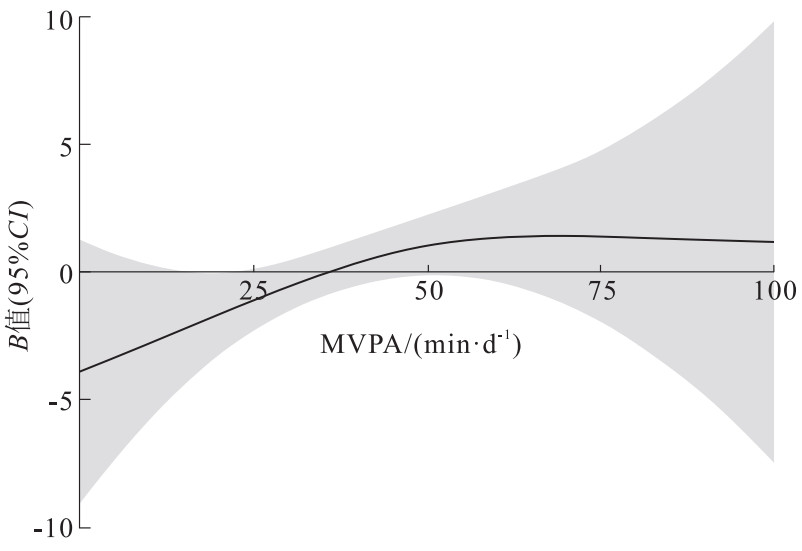Association of physical activity and sedentary behavior with cardiorespiratory fitness among middle school students in Lhasa
-
摘要:
目的 探讨西藏地区中学生体力活动(PA)和久坐行为(SB)与心肺耐力(CRF)的关系,为改善西藏地区青少年心肺耐力和提高健康水平提供实证参考。 方法 2020年8—12月,利用分层整群随机抽样方法从西藏拉萨市2所中学抽取1 225名13~18岁初、高中生,使用三轴加速度计评估PA和SB行为,采用20 m往返跑对中学生CRF进行评估。采用等时替代模型分析SB、低强度体力活动(LPA)、中高强度体力活动(MVPA)与CRF的关联,并通过限制性立方样条和两分段线性回归分析MVPA与CRF剂量-效应关系中的饱和阈值效应。 结果 等时替代分析显示,调整性别、体质量指数、睡眠质量评分等协变量后,在13~15岁初中生中,用30 min MVPA替代SB(B=1.73)和LPA(B=2.38)与CRF均呈正相关;在16~18岁高中生中,用30 min MVPA替代SB(B=0.99)和LPA(B=1.38)与CRF均呈正相关(P值均<0.05)。限制性立方样条和两分段线性回归分析表明,仅13~18岁中学女生MVPA与CRF存在饱和阈值效应关系(对数似然比检验=0.03),MVPA为60 min/d时CRF提升效果最佳(B=0.13,P<0.01)。 结论 减少SB和LPA的同时增加MVPA可改善西藏中学生CRF;中学女生为更好提升CRF效果,每天MVPA至少应达到60 min。 Abstract:Objective To explore the relationship of physical activity (PA) and sedentary behavior (SB) with cardiorespiratory fitness (CRF) among middle schoold students in Tibet, so as to provide empirical references for improving the cardiorespiratory fitness and health levels of adolescents in Tibet. Methods From August to December 2020, 1 225 junior and senior high school students were selected from 2 middle schools in Lhasa, Tibet Autonomous Region, using the stratified cluster random sampling method. Triaxial accelerometers were used to evaluate PA and SB behaviors, and the 20-meter shuttle run was employed to assess CRF among the middle school students. Isochronous substitution modeling was used to analyze the associations of SB, low-intensity physical activity (LPA), and moderate-vigorous physical activity (MVPA) with CRF, and the saturation threshold effect in the dose-response relationship between MVPA and CRF was analyzed through restricted cubic spline and two-stage linear regression. Results After adjusting for covariates such as gender, body mass index and sleep quality score, isotemporal substitution analysis showed that among junior high school students aged 13-15, replacing 30 minutes of SB (B=1.73) or LPA (B=2.38) with MVPA were positively associated with CRF (both P < 0.05). Among senior high school students aged 16-18, replacing SB (B=0.99) or LPA (B=1.38) with MVPA were also positively associated with CRF (both P < 0.05). Restricted cubic spline and two-piecewise linear regression analyses indicated that only middle school girls aged 13-18 exhibited a saturation threshold effect between MVPA and CRF (logarithmic likelihood ratio test=0.03), with the optimal CRF improvement observed at 60 minutes of MVPA per day (B=0.13, P < 0.01). Conclusions Reducing SB and LPA while increasing MVPA can improve CRF in Tibetan middle school students. To maximize CRF improvement, middle school girls should engage in at least 60 minutes of MVPA daily. -
Key words:
- Motor activity /
- Sedentary lifestyle /
- Heart /
- Lung /
- Isotemporal substitution /
- Adolescent /
- Minority groups
1) 利益冲突声明 所有作者声明无利益冲突。 -
表 1 拉萨市各年龄组不同性别中学生基本指标比较(x±s)
Table 1. Comparison of basic indicators among middle school students of different genders and age groups in Lhasa(x±s)
年龄/岁 性别 人数 统计值 BMI/(kg·m-2) 睡眠质量评分 VO2max/[mL·(kg·min)-1] SB/(min·d-1) LPA/(min·d-1) MVPA/(min·d-1) 配戴加速度计时间/(min·d-1) 13~15 男 314 18.73±3.31 3.44±2.17 40.44±4.40 737.60±57.95 85.79±22.88 53.85±16.97 877.23±56.17 女 348 18.83±2.98 3.84±2.10 35.90±3.18 769.09±65.26 74.25±18.71 41.85±12.35 885.19±62.23 t值 -0.39 -2.27 14.91 -6.53 7.05 10.30 -1.73 P值 0.43 0.08 < 0.01 < 0.01 < 0.01 < 0.01 0.09 16~18 男 264 20.49±3.27 3.63±2.33 40.34±5.67 781.87±68.09 70.09±19.36 58.72±16.04 910.68±61.96 女 299 20.66±3.10 4.18±2.40 33.67±3.84 809.11±61.63 69.54±17.07 47.62±12.22 926.27±61.74 t值 -0.61 -2.11 16.03 -4.98 0.35 9.15 -2.99 P值 0.54 0.04 < 0.01 < 0.01 0.72 < 0.01 < 0.01 -
[1] 杨小芳. 儿童青少年心肺耐力测评方法及其特征的研究[D]. 上海: 华东师范大学, 2021.YANG X F. Study on the evaluation methods and characteristics of cardiorespiratory fitness in children and adolescents[D]. Shanghai: East China Normal University, 2021. (in Chinese) [2] TOMLINSON L, ERSEK M, THOMPSON N, et al. Temporal trends in the cardiorespiratory fitness of children and adolescents: a systematic review[J]. Br J Sports Med, 2022, 56(4): 225-232. [3] LAVIE C J, OZEMEK C, CARBONE S, et al. Sedentary behavior, exercise, and cardiovascular health[J]. Circ Res, 2019, 124(5): 799-815. doi: 10.1161/CIRCRESAHA.118.312669 [4] CHEN X, MA J, DONG L, et al. The association between physical activity and lung function in adolescents: a cross-sectional NHANES study[J]. Front Med, 2025, 12: 1538221. doi: 10.3389/fmed.2025.1538221 [5] 李辉, 王乐. 24 h活动行为对中心性肥胖中学生身体形态与心肺耐力影响的替代效益[J]. 中国学校卫生, 2025, 46(5): 662-666. doi: 10.16835/j.cnki.1000-9817.2024329LI H, WANG L. Alternative benefits of 24-hour activity behavior on the physical shape and cardiorespiratory endurance of middle school students with central obesity[J]. Chin J Sch Health, 2025, 46(5): 662-666. (in Chinese) doi: 10.16835/j.cnki.1000-9817.2024329 [6] 陈泽刚, 丁吉, 万芹, 等. 中国儿童青少年体力活动与心肺耐力的相关性[J]. 中国学校卫生, 2022, 43(3): 429-432. doi: 10.16835/j.cnki.1000-9817.2022.03.027CHEN Z G, DING J, WAN Q, et al. Association between physical activity and cardiopulmonary endurance of Chinese children and adolescents[J]. Chin J Sch Health, 2022, 43(3): 429-432. (in Chinese) doi: 10.16835/j.cnki.1000-9817.2022.03.027 [7] MARQUES A, SANTOS R, EKELUND U, et al. Association between physical activity, sedentary time, and healthy fitness in youth[J]. Med Sci Sports Exerc, 2015, 47(3): 575-580. doi: 10.1249/MSS.0000000000000426 [8] EVENSON K R, CATELLIER D J, GILL K, et al. Calibration of two objective measures of physical activity for children[J]. J Sports Sci, 2008, 26(14): 1557-1565. doi: 10.1080/02640410802334196 [9] TROST S G, LOPRINZI P D, MOORE R, et al. Comparison of accelerometer cut points for predicting activity intensity in youth[J]. Med Sci Sports Exerc, 2011, 43(7): 1360-1368. doi: 10.1249/MSS.0b013e318206476e [10] OLDS T, TOMKINSON G, LÉGER L, et al. Worldwide variation in the performance of children and adolescents: an analysis of 109 studies of the 20-m shuttle run test in 37 countries[J]. J Sports Sci, 2006, 24(10): 1025-1038. doi: 10.1080/02640410500432193 [11] MATSUZAKA A, TAKAHASHI Y, YAMAZOE M, et al. Validity of the multistage 20-m shuttle-run test for Japanese children, adolescents, and adults[J]. Pediatr Exerc Sci, 2004, 16(2): 113-125. doi: 10.1123/pes.16.2.113 [12] BUYSSE D J, REYNOLDS C F, MONK T H, et al. The Pittsburgh Sleep Quality Index: a new instrument for psychiatric practice and research[J]. Psychiatry Res, 1989, 28(2): 193-213. doi: 10.1016/0165-1781(89)90047-4 [13] 路桃影, 李艳, 夏萍, 等. 匹兹堡睡眠质量指数的信度及效度分析[J]. 重庆医学, 2014, 43(3): 260-263.LU T Y, LI Y, XIA P, et al. Analysis on reliability and validity of the Pittsburgh Sleep Quality Index[J]. Chongqing Med, 2014, 43(3): 260-263. (in Chinese) [14] 王悦, 余程东, 杨兴堂, 等. 匹兹堡睡眠质量指数在患近视青少年中的信效度评价[J]. 现代预防医学, 2019, 46(6): 1062-1065, 1069.WANG Y, YU C D, YANG X T, et al. Reliability and validity evaluation of the Pittsburgh Sleep Quality Index in adolescents with myopia[J]. Mod Prev Med, 2019, 46(6): 1062-1065, 1069. (in Chinese) [15] MEKARY R A, DING E L. Isotemporal substitution as the gold standard model for physical activity epidemiology: why it is the most appropriate for activity time research[J]. Int J Environ Res Public Health, 2019, 16(5): 797. doi: 10.3390/ijerph16050797 [16] MEKARY R A, WILLETT W C, HU F B, et al. Isotemporal substitution paradigm for physical activity epidemiology and weight change[J]. Am J Epidemiol, 2009, 170(4): 519-527. doi: 10.1093/aje/kwp163 [17] SANTOS D A, MARQUES A, MINDERICO C S, et al. A cross-sectional and prospective analyse of reallocating sedentary time to physical activity on children's cardiorespiratory fitness[J]. J Sports Sci, 2018, 36(15): 1720-1726. doi: 10.1080/02640414.2017.1411176 [18] JONES M A, SKIDMORE P M, STONER L, et al. Associations of accelerometer-measured sedentary time, sedentary bouts, and physical activity with adiposity and fitness in children[J]. J Sports Sci, 2020, 38(1): 114-120. doi: 10.1080/02640414.2019.1685842 [19] SUN F, WILLIAMS C A, SUN Q, et al. Effect of eight-week high-intensity interval training versus moderate-intensity continuous training programme on body composition, cardiometabolic risk factors in sedentary adolescents[J]. Front Physiol, 2024, 15: 1450341. doi: 10.3389/fphys.2024.1450341 [20] FANG C, ZHANG J, ZHOU T, et al. Associations between daily step counts and physical fitness in preschool children[J]. J Clin Med, 2020, 9(1): 163. doi: 10.3390/jcm9010163 [21] FAßBENDER D M, KREFFTER K, GÖTZ S, et al. Is the level of motor development at school entry related to the use of municipal exercise programs? A social-differential analysis[J]. Int J Environ Res Public Health, 2022, 19(5): 3047. doi: 10.3390/ijerph19053047 [22] YAN W, NIE M, MA R, et al. The influence of physical literacy of student with different obesity levels on physical fitness: the mediating effect of MVPA[J]. Front Public Health, 2024, 12: 1463108. doi: 10.3389/fpubh.2024.1463108 [23] VAN DER FELS I M J, HARTMAN E, BOSKER R J, et al. Effects of aerobic exercise and cognitively engaging exercise on cardiorespiratory fitness and motor skills in primary school children: a cluster randomized controlled trial[J]. J Sports Sci, 2020, 38(17): 1975-1983. doi: 10.1080/02640414.2020.1765464 [24] HARTWIG T B, SANDERS T, VASCONCELLOS D, et al. School-based interventions modestly increase physical activity and cardiorespiratory fitness but are least effective for youth who need them most: an individual participant pooled analysis of 20 controlled trials[J]. Br J Sports Med, 2021, 55: 721-729. doi: 10.1136/bjsports-2020-102740 [25] STEELE J R, COLTMAN C E, MCGHEE D E. Effects of obesity on breast size, thoracic spine structure and function, upper torso musculoskeletal pain and physical activity in women[J]. J Sport Health Sci, 2020, 9(2): 140-148. doi: 10.1016/j.jshs.2019.05.003 [26] 唐毅, 宋云峰, 杜以民, 等. 基于等时替代模型分析儿童青少年24小时活动行为与心肺耐力的关联[J]. 中国儿童保健杂志, 2024, 32(8): 826-831, 855.TANG Y, SONG Y F, DU Y M, et al. Association between 24-hour activity behavior and cardiorespiratory endurance in children and adolescents based on isochronous substitution models[J]. Chin J Child Health Care, 2024, 32(8): 826-831, 855. (in Chinese) [27] DE FARIA F R, BARBOSA D, HOWE C A, et al. Time-use movement behaviors are associated with scores of depression/anxiety among adolescents: a compositional data analysis[J]. PLoS One, 2022, 17(12): e0279401. doi: 10.1371/journal.pone.0279401 [28] KITANO N, KAI Y, JINDO T, et al. Compositional data analysis of 24-hour movement behaviors and mental health in workers[J]. Prev Med Rep, 2020, 20: 101213. doi: 10.1016/j.pmedr.2020.101213 [29] DUMUID D, WAKE M, CLIFFORD S, et al. The association of the body composition of children with 24-hour activity composition[J]. J Pediatr, 2019, 208: 43-49. doi: 10.1016/j.jpeds.2018.12.030 [30] KANDOLA A A, DEL POZO C B, OSBORN D P J, et al. Impact of replacing sedentary behaviour with other movement behaviours on depression and anxiety symptoms: a prospective cohort study in the UK Biobank[J]. BMC Med, 2021, 19(1): 133. doi: 10.1186/s12916-021-02007-3 [31] CABANAS-SÁNCHEZ V, MARTÍNEZ-GÓMEZ D, IZQUIERDO-GÓMEZ R, et al. Association between clustering of lifestyle behaviors and health-related physical fitness in youth: the UP&DOWN study[J]. J Pediatr, 2018, 199: 41-48.e1. doi: 10.1016/j.jpeds.2018.03.075 [32] 全明辉, 方春意, 周傥, 等. 学龄前儿童不同簇集特征体力活动与体质健康的剂量-效应关系研究[J]. 体育科学, 2020, 40(3): 39-45.QUAN M H, FANG C Y, ZHOU T, et al. Dose-response relationship between bouts of physical activity and physical health in preschool children[J]. China Sport Sci, 2020, 40(3): 39-45. (in Chinese) [33] KIM J, LEE S, PARK H, et al. Differential effects of moderate vs. vigorous physical activity on cardiorespiratory fitness in adolescent boys: a longitudinal mediation analysis[J]. J Pediatr, 2023, 252: 153-160.e2. [34] CABANAS-SÁNCHEZ V, MARTÍNEZ-GÓMEZ D, IZQUIERDO-GÓMEZ R, et al. Sex-specific associations between intensity-specific physical activity and cardiorespiratory fitness in adolescents: the UP&DOWN study[J]. Int J Environ Res Public Health, 2021, 18(16): 8602. doi: 10.3390/ijerph18168602 -







 下载:
下载:

